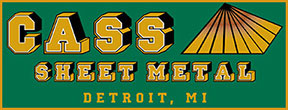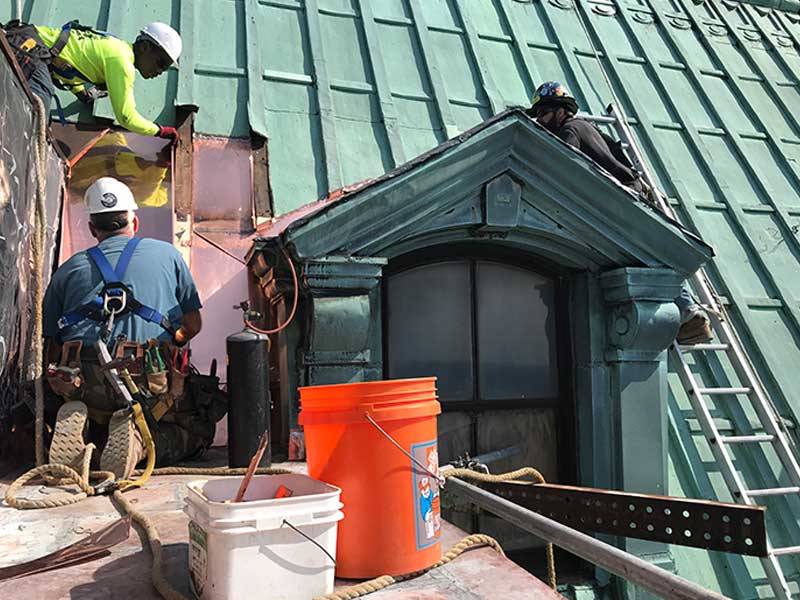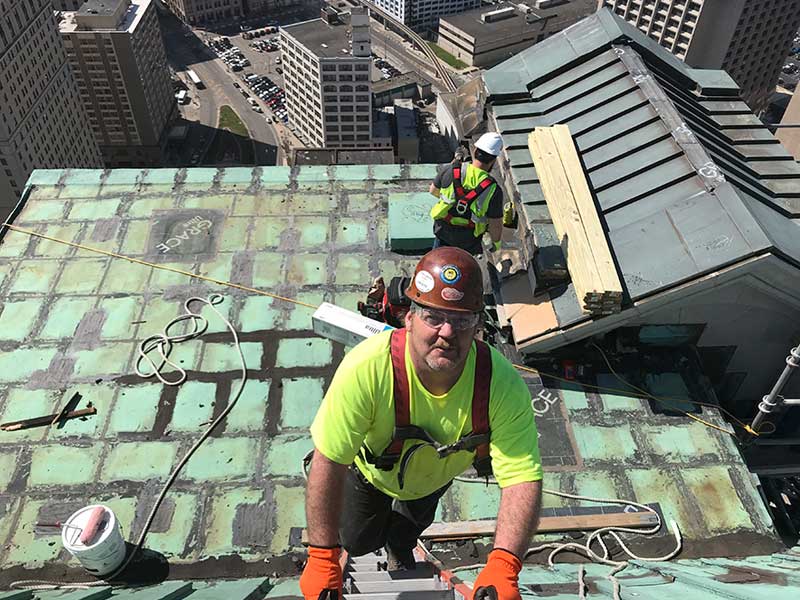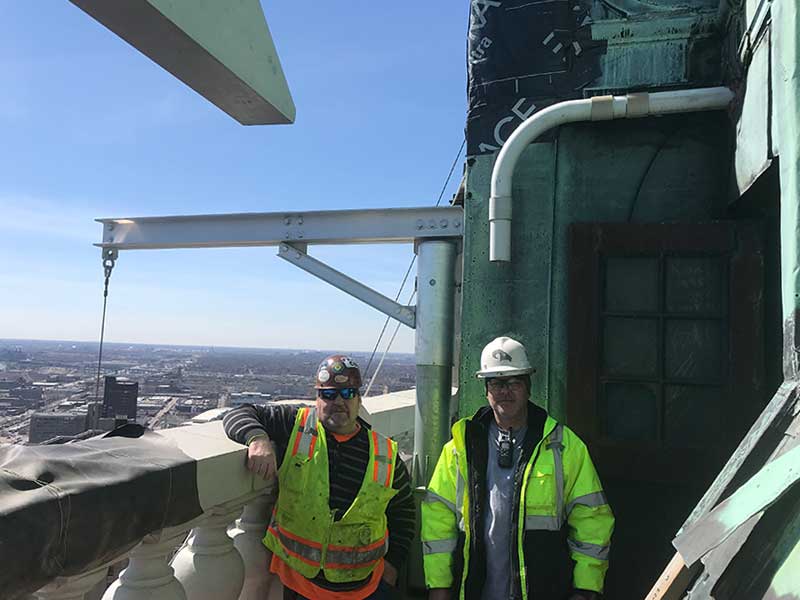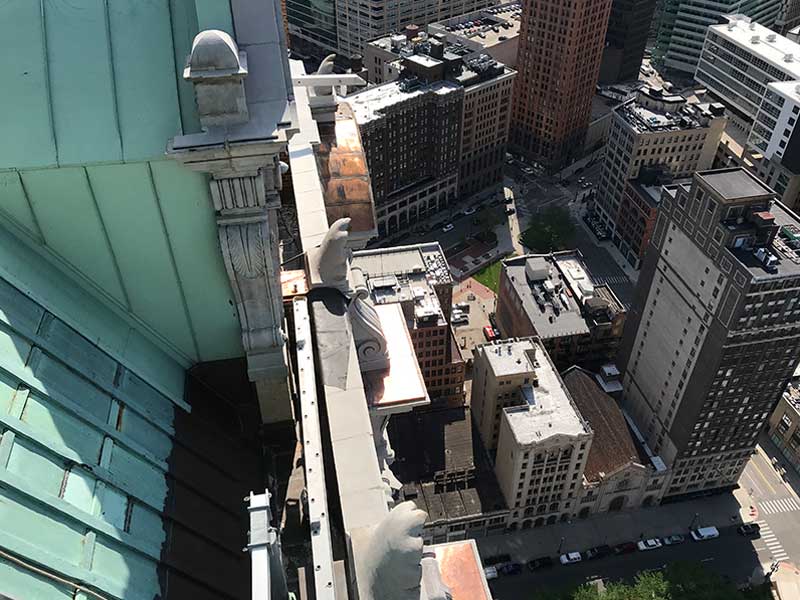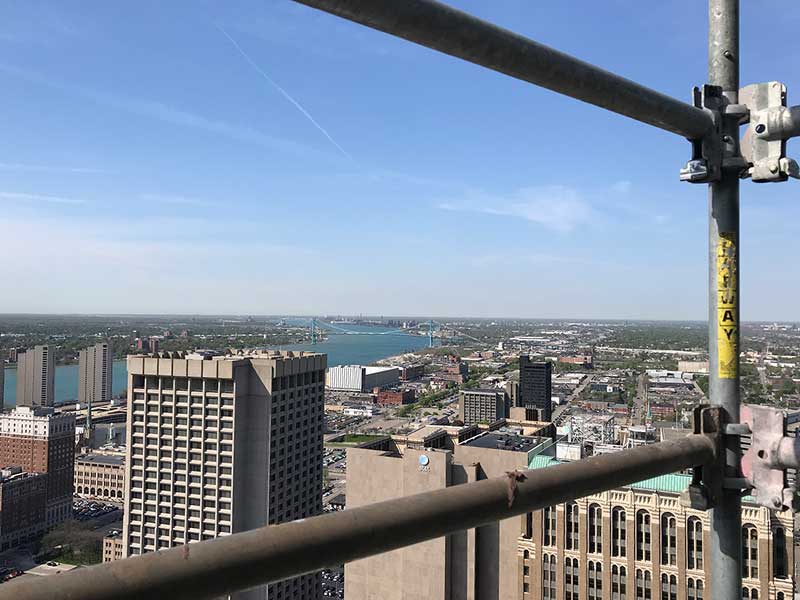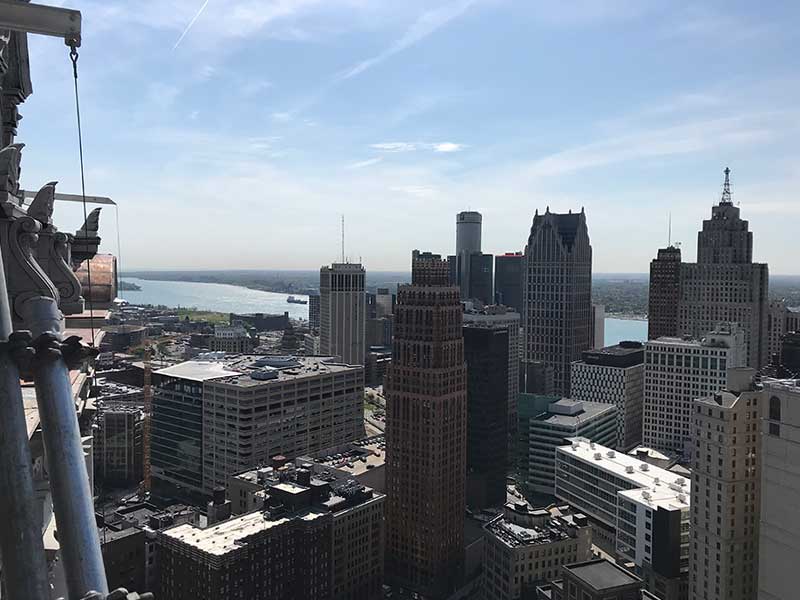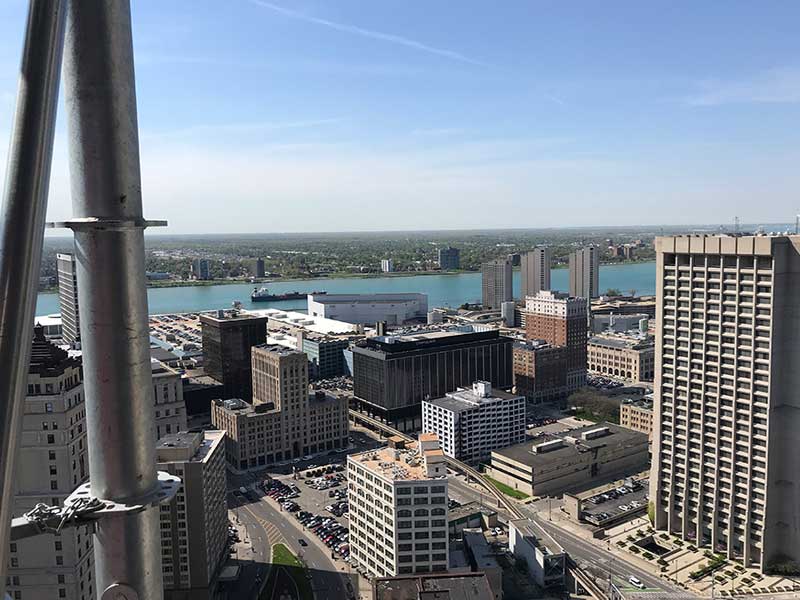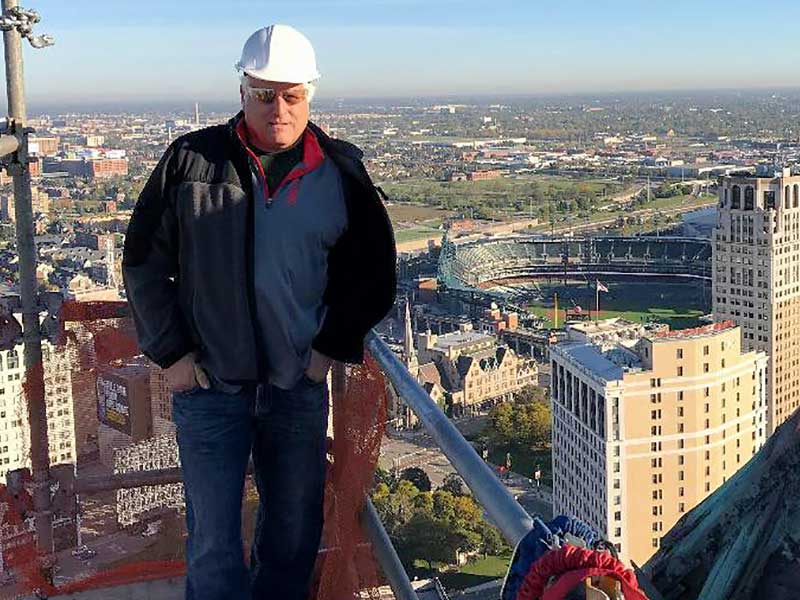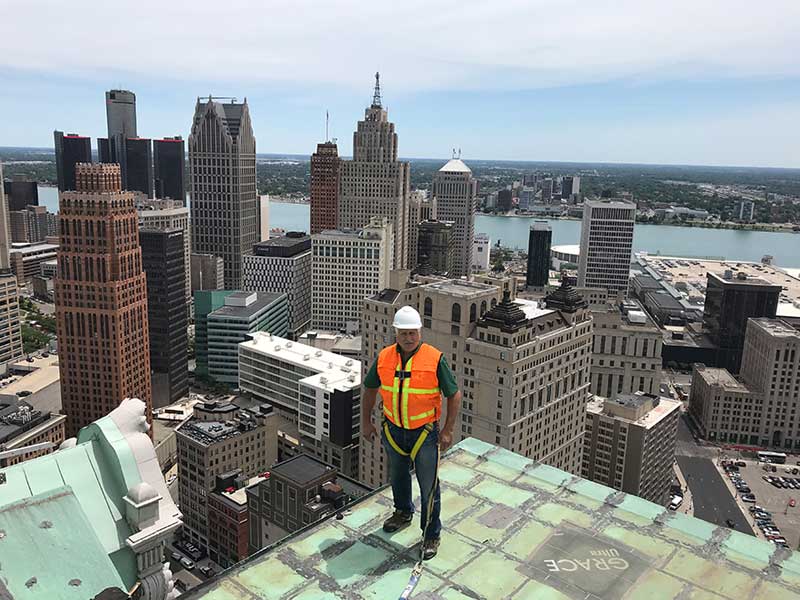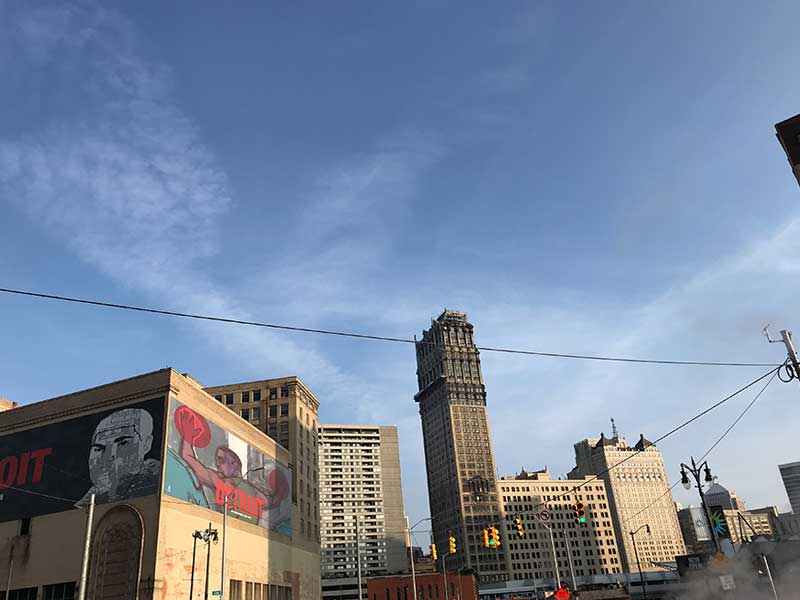CASS IN THE NEWS!
Book Tower - Detroit, MI
Iconic Building Restoration of a Detroit Landmark
NEWS ARTICLE - Featured in CAM Magazine – May 2018. Read the full story below.
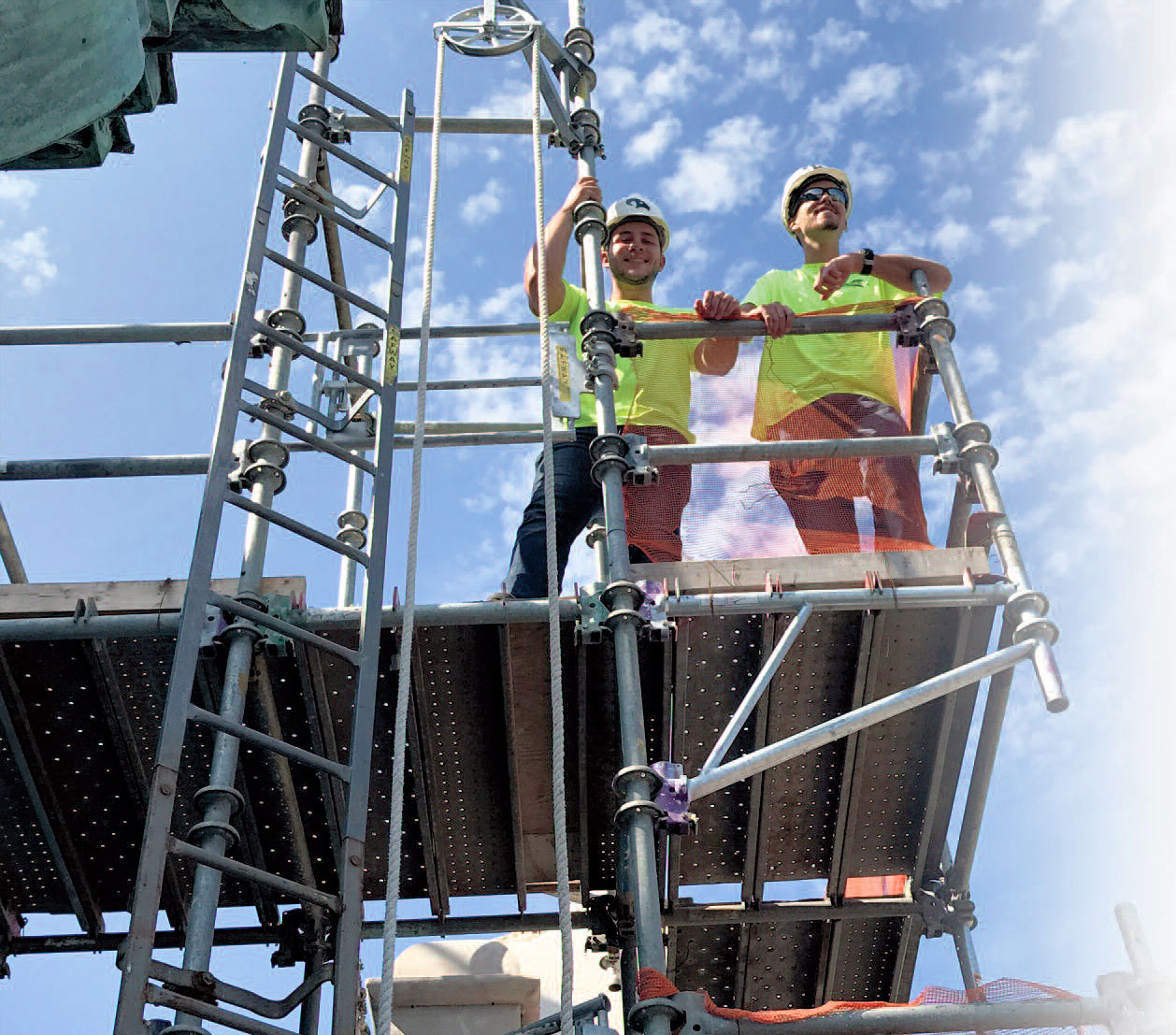
A “By the Book” Restoration of a Detroit Landmark
A “By the Book” Restoration of a Detroit Landmark
For over a year, CASS Sheetmetal President Glenn Parvin has taken the
freight elevator to the 36th floor of the Book Tower in downtown Detroit, walked a flight of stairs to the attic, and squeezed through a few tight spaces to stand in the open air at the upper reaches of one of Detroit’s landmark buildings. “The vantage point is unbelievable,” said Parvin. “I can see Little Caesars Arena, Comerica Park, the Detroit River and the Ambassador Bridge in this crow’s-eye view.”
But Parvin has another way of seeing. He views the building and the surrounding city-scape through the detailed eye of a craftsman intent on contributing his knowledge to the restoration of another once-abandoned part of Detroit. Parvin and his 28-year-old company are doing things “by the book” to bring the Book Tower back to life. Every soldered copper cap flashing and every barrel-vaulted copper roof are textbook examples of quality workmanship.
CASS Sheetmetal is even correcting some improper copper details of the original building, going above and beyond the call of duty as a trade contractor working under contract to RAM Construction Services. Once complete, the Book Tower’s steeply sloped roof will be restored to its full copper glory, along with the building’s water tables, gutters and its copper spandrel panels ornamented in three different patterns.
CASS Sheetmetal Conquers the Restoration of Detroit’s iconic BOOK TOWER!
A High-Rise Construction Site
Bedrock Real Estate Services as owner and Walker Restoration Consultants as engineers respect CASS Sheetmetal’s high level of expertise. Working closely with both Walker and with RAM Construction Services’ project managers and superintendents, CASS has been granted a fairly significant decision-making role in determining whether to repair or replace the varied copper components of this 38-story building.
“The fact that they had the confidence in our firm to play a role in somewhat of a design-assist approach to much of the copper detail and restoration work on the Book Tower means a great deal,” said Parvin. “We are playing a fairly significant role when it comes to details that not only meet the historical intent but also improve the details in question, or in other cases, simplify details while still respecting the building’s Old World craftsmanship.”
CASS Sheetmetal’s “baptism” on the Book Tower began almost immediately after its arrival on site in June 2017. The Book Tower has several barrelvaulted copper roofs at the 36th floor. These eyebrow-shaped curves are located just below the base of the sloped roof and just outside the pilaster (non-supporting, architectural columns) wall at the building’s upper reaches.
At this 475-foot-high construction site, access for the purpose of determining an exact scope of work can be challenging. “Several of the vaulted copper roofs can only be safely accessed from the mast climber,” said Parvin. At the time of scope formation, the mast climber was located elsewhere on the wall; once set in place, a mast climber is not easily re-positioned. After access was achieved and the handson assessment was complete, the scope of work on the barrel vaults had to be expanded. Welcome to the world of high-rise historical restoration and renovation.
As part of the work itself, CASS replaced the barrel vaults, installing new copper flashing and even correcting some of the original details not in line with modern construction practices. Future access was also a factor in deciding to replace these difficult-to-reach, barrel-vaulted roofs. “It is better to replace the barrel vaults now, because returning to these areas will be very difficult,” said Parvin. “Future access also drove other decisions on the project as well.”
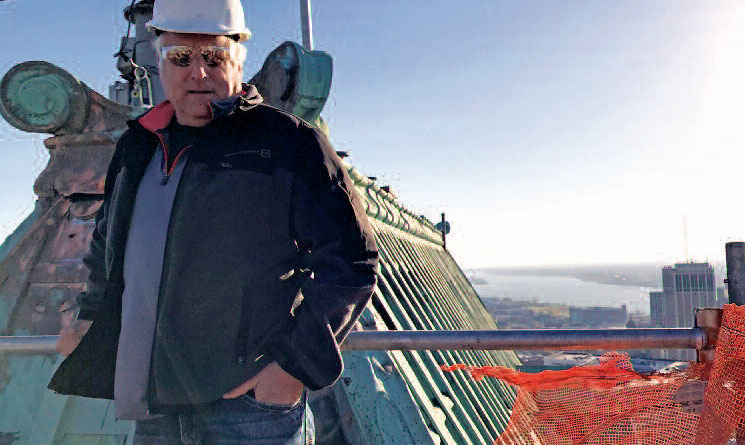
CASS Sheetmetal President Glenn Parvin enjoys a bird’s-eye view of Detroit from the top of the Book Tower. Parvin and the entire CASS Sheetmetal team brought the detailed eyes and skilled hands of their collective craftsmanship to the restoration of this remarkable building.
Restoring the Rooftop
The CASS Sheetmetal team had to leave the comfort of the mast climber to access the sloped roof. The route through the Book Tower’s attic ultimately leads to the building’s gutter area, but CASS had to devise safe access solutions to reach the sloped roof and its series of dormers. These solutions included a series of planks, roped-off ladders, plank-like aluminum picks, and protective scaffolding. Being 100 percent tied off is mandatory, and certainly no one would object when working off a scaffold or climbing a 40-foot ladder on a sloped roof almost 500 feet above street level.
The access challenges inherent in working on a towering skyscraper add to the cost of material delivery and safety, and also increase the amount of time needed to arrive at a jobsite perched at such a height. Salvaging as much as possible of the existing copper roof and other copper elements embraces the true spirit of restoration, and also helps to contain a budget already increased by access logistics.
CASS has been meticulously evaluating, and either repairing or replacing, the heavily ornamented building’s copper roof over the course of the last year. “The mindset was not necessarily to completely reroof the building,” said Parvin. “The mindset was to keep what is salvageable and beyond that to replace only what was absolutely necessary.”
The spirit is willing, but the copper might potentially be weak. “We brought in a consultant to test some of the copper to see that it still had significant life,” said Parvin. Details of the batten system, the roof hips and the decorative elements at the very top of the roof were analyzed as well.
CASS Custom Architectural Sheetmetal Specialists - Detroit, MI
Glenn Parvin highlights his company’s work on the Book Tower roof from bottom to top:
• Replacing a Gutter with a Five-Foot Girth:
This comprehensive restoration of one of Detroit’s iconic rooftops began with the replacement of a large gutter located on the 36th level and at the very base of the sloped copper roof. “The original gutter is one of the elements that had failed throughout the years and caused a great deal of leakage in the building,” said Parvin.
CASS first replaced the concrete plank deck supporting the gutter. “It was rotted away at the base where the gutter was, so we infilled that area with new metal decking, plywood and gypsum to give us a strong base to construct the built-in gutter,” said Parvin. CASS then replaced and installed this “large, built-in copper flat seam gutter that has a girth of about five feet from point to point,” added Parvin.
• From Asphalt Mastic to Copper:
Over the years, a maze of antennas, satellite equipment and other devices had penetrated the roof’s batten standing seam copper panels and the six dormers on this windy and sometimes cold pinnacle. For decades, asphalt mastic was used to seal the equipment penetrations and to repair different areas of the copper roof. This solution sends chills down the spine of a true copper craftsman like Parvin. “The method of resealing these equipment areas and repairing various details with asphalt mastic does not work with copper roofing,” said Parvin. “Repairs all around the existing building were done improperly by those who used mastic and who didn’tunderstand how to flash copper. Today, every piece of asphalt mastic on that job is getting redone with copper.”
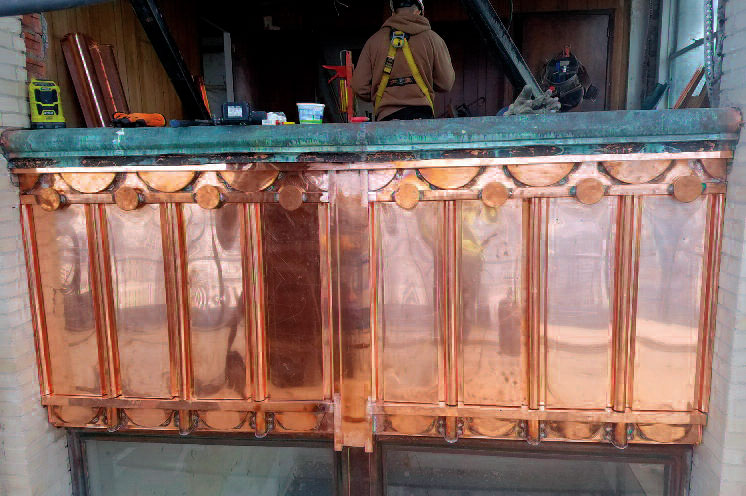
CASS Sheetmetal replaced, but mainly repaired, the ornate, copper spandrel panels located on three different floors of the Book Tower. Shown above, one of the newly replicated spandrel panels is aglow in new copper. Ultimately, CASS sprayed a patina accelerator on the newly fabricated copper to blend it with the seasoned, greenish-blue color of the existing spandrels.
• A Panel-by-Panel Evaluation:
Tasked with retaining as much of the original copper roof as possible, CASS helped to evaluate the salvageable versus the replaceable sections of copper roof panels. As a general rule of thumb, if the number of patches and equipment penetrations exceeded a certain number in a given area, or if the original repair resulted in severely split metal, the copper panels were replaced in that section.
A 10-by-10-foot-wide swath near the top of the roof’s triangular-shaped west elevation was replaced with new copper, the west typically being the direction of the most wicked weather. “We also replaced all the copper on the west elevation’s small dormer because it was in such bad shape,” added Parvin.
• Pre-Patinated Copper Dormers:
A series of dormers adds character to the Book Tower’s roof. The array of antennas, wires and other equipment had actually inflicted a large number of holes in the dormers, leading CASS to install new copper on all the dormer wall panels and roofs because of the sheer amount of repair and patching work that would have been necessary. To seamlessly blend existing and new copper, CASS sprayed a patina accelerator and used pre-patinated copper sheets to turn that shiny copper glow into the seasoned greenish-blue color of mature, weathered copper. This strategy was used in all of the exposed copper elements, including the repair of the ornate spandrel panels on the tower’s wall.
• Working on the Head of a Pin:
Later in 2018, CASS will replace the roof section at the very top of the building. For those who would enjoy being an angel dancing on the head of a very high pin, the Book Tower is a godsend. The very apex of the roof is actually only a five-foot-wide slot of built-up roof that will soon be returning to a flat seam copper deck. Shinny or rappel 12 feet down, and the next stop is the roof of the Book Tower’s mechanical room. The CASS team will be replacing and installing a new copper flat seam deck for this area as well. Ultimately, the roof of the Book Tower will be completely restored as a 100 percent copper beacon.
• Handcrafted Wall Panels
CASS’s craftsmanship is bringing the exterior walls back to life as well, both in form and function. The CASS Sheet Metal crew replaced, but mainly repaired, the ornate, copper spandrel panels located on three different floors, each floor having a slightly different design.
CASS replaced 10 missing spandrel panels, some of which had been lost in the severe windstorm of March 2017. “The new panels are all hand-built and custom-fabricated in our shop,” said Parvin. “We did it the way it was done in the 1920s. Everything on the job is from flat stock, and every new copper piece was custom-built in our shop to match historical requirements.”
In the spirit of restoration, however, the majority of the spandrel panels were repaired. “Since the 1920s various screws and wires had been driven into the panels to keep it in place,” said Parvin, “and these holes, like the ones in the roof panels, had been filled with asphalt patches. In some cases, the holes were leading to a split in the metal. We used copper patches to repair the panels, making sure we fixed any splits and secured the panels to the building.”
Another building maintenance habit of the past led to further repairs. Over the years, the Book Tower’s window washers would dangle heavy ropes over the window sill to help support their work platform. CASS discovered that the bullnose sill flashings, located under the window sills and above the spandrel panels, were damaged from decades of the ropes rubbing against the window sills. CASS replaced the damaged bullnoses and even created an overlay for the new flashings. “We worked closely with the window replacement contractor to replace the bull-noses when they were working on a floor,” said Parvin. CASS Sheetmetal is meticulously stitching the copper elements of the Book Tower back together again, including the copper elements of the water tables, located on four different floors. “The water tables received a new soldered copper deck, new copper drains and new copper drain piping,” said Parvin. “CASS was responsible for getting the piping into the building, so that the plumber could attach to the copper piping.”
For access to the spandrel panels and water tables, all located in the upper third of the building, CASS shared and coordinated its schedule with RAM for use of the mast climber. “We often worked overtime to make full use of the mast climber,” said Parvin. “When it came time to work on the water tables at each of the different building levels, it was all hands-on deck, so we could shorten the duration of our use of the mast climber.”
As of March 2018, CASS’s portion of the work was approximately 50 percent complete. CASS has been working its way down a 40-line item proposal, along with some additional work. “All materials and labor are tracked and documented on a monthly billing cycle per the owner’s request,” added Parvin.
CASS Sheetmetal has had its “nose in the Book” for almost a year, closely examining, repairing and replacing this landmark building’s copper components. Glenn Parvin and the entire CASS Sheetmetal team bring the spirit of true craftsmanship to the restoration of this challenging building. At the end of the day, the entire Detroit area is fortunate to have a local, homegrown Detroit-based company dedicated to bringing Detroit’s historical buildings back to life.
CAM Magazine – Voice of the Construction Industry – May 2018
